Effect of Transverse Isotropy on Tensile Strength And Elastic Modulus of Phu Phan Sandstone
Main Article Content
Abstract
This research aims to investigate the effects of transverse isotropy on tensile strength and elastic modulus of Phu Phan sandstone. The dimensions of disk-shaped specimens were 74 mm diameter and 37 mm thickness. Brazilian tension tests were performed under two stress states: 1) under uniaxial stress direction with bedding planes normal and parallel to core axis and 2) under biaxial stress state with bedding planes parallel to the core axis. The test results indicate that strengths are largest when bedding planes are normal to loading diameter. They gradually decrease to the smallest value when the beds are parallel to the loading direction. The tensile elastic moduli are lower than the compressive elastic moduli. This is because the effort required to dilate the pore spaces and fissures in the rocks under compressive loading is higher than that to contract them under tensile loading. The Poisson’s ratio under uniaxial stress direction decreases with increasing inclination angles. The findings obtained here can be used to assess the stability of sandstone tunnels and underground excavations.
Article Details

This work is licensed under a Creative Commons Attribution-NonCommercial-NoDerivatives 4.0 International License.
The articles published are the opinion of the author only. The author is responsible for any legal consequences. That may arise from that article.
References
K. Fuenkajorn and S. Klanphumeesri, “Direct tension tests of intact rocks using compressionto- tension load converter,” Engineering Journal of Research and Development, vol. 21, no. 2, pp. 51–57, 2010.
D. A. Newman and D. G. Bennett, “The effect of specimen size and stress rate for the Brazilian test - A statistical analysis,” Rock Mechanics and Rock Engineering, vol. 23, no. 2, pp. 123–134, 1990.
C. Rocco, G. V. Guinea, J. Planas, and M. Elices, “Size effect and boundary conditions in the Brazilian test: Theoretical analysis,” Materials and Structures, vol. 23, no. 6, pp. 437–444, 1999.
K. Thuro, R. J. Plinninger, S. Zah, and S. Schutz, “Scale effects in rock strength properties. Part 1: Unconfined compressive test and Brazilian test,” in Proceedings of the EUROCK, Finland, 2001, pp. 169–174.
Y. Yu, J. Yin, and Z. Zhong, “Shape effects in the Brazilian tensile strength test and a 3D FEM correction,” International Journal of Rock Mechanics and Mining Sciences, vol. 43, no. 4, pp. 623–627, 2006.
J. Kodama, T. Goto, Y. Fujii, and P. Hagan, “The effects of water content, temperature and loading rate on strength and failure process of frozen rocks,” International Journal of Rock Mechanics and Mining Sciences, vol. 62, pp. 1–13, 2013.
C. S. Chen, E. Pan, and B. Amadei, “Determination of deformability and tensile strength of anisotropic rock using Brazilian tests,” International Journal of Rock Mechanics and Mining Sciences, vol. 35, no. 1, pp. 43–61, 1998.
H. Wang, F. Ren, and Y. Chang, “Effect of bedding angle on tunnel slate failure behavior under indirect tension,” Natural Hazards and Risk, vol. 11, no. 1, pp. 428–445, 2020.
S. Q. Yang, P. F. Yin, B. Li, and D. S. Yang, “Behavior of transversely isotropic shale observed in triaxial tests and Brazilian disc tests,” International Journal of Rock Mechanics and Mining Sciences, vol. 133, 104435, 2020.
G. Hondros, “The evaluation of Poisson's ratio and the modulus of materials of low tensile resistance by the Brazilian (indirect tensile) test with particular reference to concrete,” Australian Journal of Applied Science, vol. 10, no. 3, pp. 243–268, 1959.
J. J. Liao, T. M. Yang, and Y. H. Hsieh, “Direct tensile behavior of a transversely isotropic rock,” International Journal of Rock Mechanics and Mining Sciences, vol. 34, no. 5, pp. 837–849, 1997.
Z. Xiao-jing, D. Hua-feng, Z. Heng-bin, W. Chenxie-jie, F. Jing-cheng, X. Yao, and H. Yu, “The Influence of bedding angle on the tensile strength and failure mode of bedded sandstone,” Electronic Journal of Geotechnical Engineering, vol. 21, pp. 5547–5558, 2016.
B. Amadei, “Importance of anisotropy when estimating and measuring in situ stresses in rock,” International Journal of Rock Mechanics and Mining Sciences and Geomechanics Abstracts, vol. 33, no. 3, pp. 293–325, 1996.
Y. Jianhong, F. Q. Wu, and J. Z. Sun, “Estimation of the tensile elastic modulus using Brazilian disc by applying diametrically opposed concentrated loads,” International Journal of Rock Mechanics and Mining Sciences, vol. 46, no. 3, pp. 568–576, 2009.
Standard test method for splitting tensile strength of intact rock core specimens, ASTM D3967-16, 2021.
C. C. Ma and K. M. Hung, “Exact full-field analysis of strain and displacement for circular disks subjected to partially distributed compressions,” International Journal of Mechanical Sciences, vol. 50, no. 2, pp. 275–292, 2008.
J. C. Jaeger, N. G. W. Cook, and R. W. Zimmerman, “Linear elasticity,” in Fundamentals of Rock Mechanics, 4th ed. London: Blackwell Publishing Limited, 2007, pp. 137–144.
L. Yun-si, Z. Xiao, and Y. Quan, “The five elastic parameters for the anisotropy of slate under the influence of different bedding orientations,” Electronic Journal of Geotechnical Engineering, vol. 17, pp. 3695–3707, 2012.
S. Patel and C. D. Martin, “Evaluation of tensile young’s modulus and Poisson’s ratio of a bi-modular rock from the displacement measurements in a Brazilian test,” Rock Mechanics and Rock Engineering, vol. 51, no. 2, pp. 361–373, 2018.

